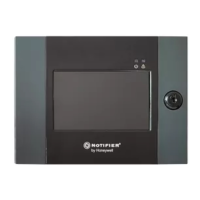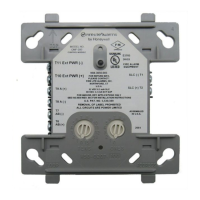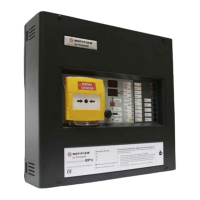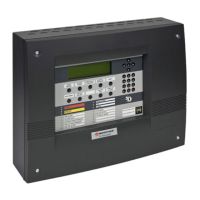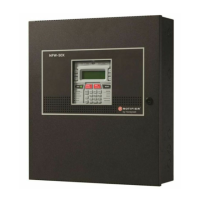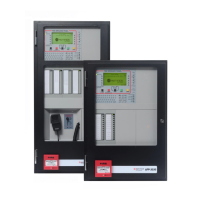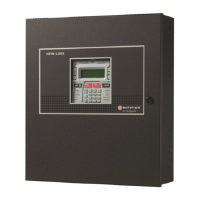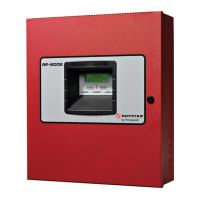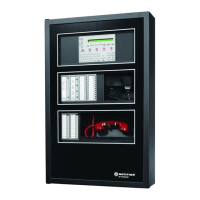Do you have a question about the Honeywell NOTIFIER NCA-2 and is the answer not in the manual?
Lists regulatory agencies and standards the NCA-2 complies with.
Details compliance with UL 864 standards, 9th and 10th editions.
Lists field-programmable software features requiring AHJ approval.
Lists related manuals and documents for compatible devices.
Explains the meaning of notes, cautions, and warnings in the manual.
Describes text and symbol conventions used throughout the manual.
Provides a general description of the NCA-2 and its capabilities.
Lists the key features and capabilities of the NCA-2.
Details compatibility with various NOTI•FIRE•NET™ compatible panels.
Explains the NCA-2's role as a remote display for displayless panels.
Describes how to use the NCA-2 in a standalone configuration with NFS2-640.
Illustrates and describes the components and connections on the NCA-2 circuit board.
Illustrates and describes the layout of the NCA-2 keypad and its keys.
Lists the basic and optional components included with the NCA-2 assembly.
Lists optional devices that connect via EIA-232, such as printers.
Describes Annunciator Control System (ACS) modules supported via EIA-485.
Lists various other optional devices that can be connected to the NCA-2.
Provides guidelines for selecting a location and preparing for installation.
A checklist of tasks required for proper installation of the NCA-2.
Instructions for mounting various cabinet and chassis types for the NCA-2.
Instructions for mounting the NCA-2 in ABS-2D and ABS-4D cabinets.
Details the layout and mounting of the NCA-2 within the CHS-M3 chassis.
Provides step-by-step instructions for mounting the NCA-2 into the CHS-M3 chassis.
Explains the function and replacement procedure for the NCA-2's memory backup battery.
Instructions for installing option boards into the CHS-M3 chassis.
Describes the CA-2 chassis assembly and NCA-2 mounting for audio command centers.
Instructions for mounting the NCA-2 with a displayless NFS2-640.
Details the Form-C relays available on the NCA-2 and their ratings.
Instructions for installing standard and high-speed network communications modules.
Illustrates setup for Canadian applications requiring a second dial-out option.
Provides an overview of power connections and sources for the NCA-2.
Details connecting the main power supply (AMPS-24/E) to the NCA-2.
Requirements for separating and routing power-limited and non-power-limited wiring.
Information on connecting printers and setting printer options.
Steps for fabricating and connecting a custom printer cable.
Guides on configuring printer settings as per its documentation.
Instructions for connecting a PC to upload/download the control panel program.
Details the AKS-1B key switch and security tamper switch for cabinet monitoring.
Describes how the NCA-2 monitors Annunciator Control System (ACS) modules.
Explains connections for LCD-160, LCD-80, and LCD2-80 displays to the NCA-2.
Provides an overview of the NCA-2 keypad, including status LEDs and keys.
Describes the nine fixed function keys and their operations.
Explains the function of special keys like Arrow Keys and +/- Keys.
Describes the function of the ten soft keys that correspond to LCD display options.
Explains the eleven LED status indicators on the NCA-2 keypad.
Describes the NCA-2's LCD display, including its size and customization.
Explains how to navigate the main menu and access different functions.
Describes the Event Counts screen, showing counts of off-normal events.
Explains how to view a list of multiple events chronologically.
Describes how to access and view local and node history logs.
How to filter local history events by time, date, or point range.
How to display or print event details for a specified network node.
How to read the status of devices and modules attached to a remote node.
Overview of accessing and using the Program/Alter Status features.
How to print reports of current settings and configurations.
Details on printing various NCA-2 configuration reports.
Describes how to print a report of the last walk test performed.
Explains the concept of events in the system and their types.
Lists and describes the fundamental categories of events displayed on the LCD.
Explains how off-normal events are handled, including acknowledgment.
Explains the default settings for acknowledging different event types.
Details the master and user password levels for system programming access.
Instructions for changing the master password and its settings.
Instructions for setting user passwords and defining access levels.
Explains the use of AKS-1B key switches for enabling/disabling keypad access.
How to access the Program/Alter Status menu using passwords.
Lists the various options available in the Alter Status Menu.
How to disable or enable individual control points on a remote fire panel node.
Instructions for adjusting detector sensitivity levels for specific points.
How to reset verification counters for detectors to prevent false alarms.
Instructions for clearing alarm, event, or all history data.
How to perform remote walk tests on network alarms.
How to change the system time, date, and time zone settings.
How to remotely turn control points on or off across the network.
Menu options for changing point or node labels on remote devices.
Instructions for naming and providing descriptions for individual points.
How to assign a descriptive label to a remote node.
Options for adjusting general operational settings for the local NCA-2.
How to configure NCA-2 network settings like node number, label, and thresholds.
General NCA-2 preferences, including local control, piezo, and event ordering.
Additional panel settings like MN Control, DCC Participation, and Defaults.
How to select regional settings like Chicago, Singapore, Australia, China, Canada.
Accessing settings for Fire Smoke Control Station (FSCS) or MSCS.
Configuration of Auto Silence and AC Fail Delay timers.
How to adjust LCD display brightness, contrast, language, and backlight.
How to program Annunciator Control System (ACS) devices connected to the NCA-2.
How to configure supervision settings for ancillary devices and ports.
Accesses the Event Logging screen for event recording configuration.
Menu for programming DVC/DAA volume or Logic Equations.
How to set audio volume levels for DVC/DAA devices.
Instructions for creating and editing logic zone equations.
How to assign labels to ACS annunciator boards.
How to assign labels to general zones for display messages.
Options for clearing panel and ACS programming information.
Explains how device trouble types and detector sensitivity translate to NCA-2 display.
Lists device point types for AM2020/AFP-1010 and their NCA-2 display equivalents.
Defines logic equations, their structure, and limitations.
Explains logic functions like AND, OR, NOT, ONLY1, ANYX, and RANGE.
Describes the normal operating status indicators on the NCA-2.
Explains alarm indicators, status, and the procedure for resetting the panel.
Describes conditions that indicate a trouble situation and how to handle it.
Explains the primary operational control functions of the NCA-2.
Explains the meaning of each LED indicator on the NCA-2 keypad.
Describes the different audible alert tones for various conditions.
Outlines steps for testing and specific requirements for remote connections.
Placeholder for local service representative contact details.
Lists regulatory agencies and standards the NCA-2 complies with.
Details compliance with UL 864 standards, 9th and 10th editions.
Lists field-programmable software features requiring AHJ approval.
Lists related manuals and documents for compatible devices.
Explains the meaning of notes, cautions, and warnings in the manual.
Describes text and symbol conventions used throughout the manual.
Provides a general description of the NCA-2 and its capabilities.
Lists the key features and capabilities of the NCA-2.
Details compatibility with various NOTI•FIRE•NET™ compatible panels.
Explains the NCA-2's role as a remote display for displayless panels.
Describes how to use the NCA-2 in a standalone configuration with NFS2-640.
Illustrates and describes the components and connections on the NCA-2 circuit board.
Illustrates and describes the layout of the NCA-2 keypad and its keys.
Lists the basic and optional components included with the NCA-2 assembly.
Lists optional devices that connect via EIA-232, such as printers.
Describes Annunciator Control System (ACS) modules supported via EIA-485.
Lists various other optional devices that can be connected to the NCA-2.
Provides guidelines for selecting a location and preparing for installation.
A checklist of tasks required for proper installation of the NCA-2.
Instructions for mounting various cabinet and chassis types for the NCA-2.
Instructions for mounting the NCA-2 in ABS-2D and ABS-4D cabinets.
Details the layout and mounting of the NCA-2 within the CHS-M3 chassis.
Provides step-by-step instructions for mounting the NCA-2 into the CHS-M3 chassis.
Explains the function and replacement procedure for the NCA-2's memory backup battery.
Instructions for installing option boards into the CHS-M3 chassis.
Describes the CA-2 chassis assembly and NCA-2 mounting for audio command centers.
Instructions for mounting the NCA-2 with a displayless NFS2-640.
Details the Form-C relays available on the NCA-2 and their ratings.
Instructions for installing standard and high-speed network communications modules.
Illustrates setup for Canadian applications requiring a second dial-out option.
Provides an overview of power connections and sources for the NCA-2.
Details connecting the main power supply (AMPS-24/E) to the NCA-2.
Requirements for separating and routing power-limited and non-power-limited wiring.
Information on connecting printers and setting printer options.
Steps for fabricating and connecting a custom printer cable.
Guides on configuring printer settings as per its documentation.
Instructions for connecting a PC to upload/download the control panel program.
Details the AKS-1B key switch and security tamper switch for cabinet monitoring.
Describes how the NCA-2 monitors Annunciator Control System (ACS) modules.
Explains connections for LCD-160, LCD-80, and LCD2-80 displays to the NCA-2.
Provides an overview of the NCA-2 keypad, including status LEDs and keys.
Describes the nine fixed function keys and their operations.
Explains the function of special keys like Arrow Keys and +/- Keys.
Describes the function of the ten soft keys that correspond to LCD display options.
Explains the eleven LED status indicators on the NCA-2 keypad.
Describes the NCA-2's LCD display, including its size and customization.
Explains how to navigate the main menu and access different functions.
Describes the Event Counts screen, showing counts of off-normal events.
Explains how to view a list of multiple events chronologically.
Describes how to access and view local and node history logs.
How to filter local history events by time, date, or point range.
How to display or print event details for a specified network node.
How to read the status of devices and modules attached to a remote node.
Overview of accessing and using the Program/Alter Status features.
How to print reports of current settings and configurations.
Details on printing various NCA-2 configuration reports.
Describes how to print a report of the last walk test performed.
Explains the concept of events in the system and their types.
Lists and describes the fundamental categories of events displayed on the LCD.
Explains how off-normal events are handled, including acknowledgment.
Explains the default settings for acknowledging different event types.
Details the master and user password levels for system programming access.
Instructions for changing the master password and its settings.
Instructions for setting user passwords and defining access levels.
Explains the use of AKS-1B key switches for enabling/disabling keypad access.
How to access the Program/Alter Status menu using passwords.
Lists the various options available in the Alter Status Menu.
How to disable or enable individual control points on a remote fire panel node.
Instructions for adjusting detector sensitivity levels for specific points.
How to reset verification counters for detectors to prevent false alarms.
Instructions for clearing alarm, event, or all history data.
How to perform remote walk tests on network alarms.
How to change the system time, date, and time zone settings.
How to remotely turn control points on or off across the network.
Menu options for changing point or node labels on remote devices.
Instructions for naming and providing descriptions for individual points.
How to assign a descriptive label to a remote node.
Options for adjusting general operational settings for the local NCA-2.
How to configure NCA-2 network settings like node number, label, and thresholds.
General NCA-2 preferences, including local control, piezo, and event ordering.
Additional panel settings like MN Control, DCC Participation, and Defaults.
How to select regional settings like Chicago, Singapore, Australia, China, Canada.
Accessing settings for Fire Smoke Control Station (FSCS) or MSCS.
Configuration of Auto Silence and AC Fail Delay timers.
How to adjust LCD display brightness, contrast, language, and backlight.
How to program Annunciator Control System (ACS) devices connected to the NCA-2.
How to configure supervision settings for ancillary devices and ports.
Accesses the Event Logging screen for event recording configuration.
Menu for programming DVC/DAA volume or Logic Equations.
How to set audio volume levels for DVC/DAA devices.
Instructions for creating and editing logic zone equations.
How to assign labels to ACS annunciator boards.
How to assign labels to general zones for display messages.
Options for clearing panel and ACS programming information.
Explains how device trouble types and detector sensitivity translate to NCA-2 display.
Lists device point types for AM2020/AFP-1010 and their NCA-2 display equivalents.
Defines logic equations, their structure, and limitations.
Explains logic functions like AND, OR, NOT, ONLY1, ANYX, and RANGE.
Describes the normal operating status indicators on the NCA-2.
Explains alarm indicators, status, and the procedure for resetting the panel.
Describes conditions that indicate a trouble situation and how to handle it.
Explains the primary operational control functions of the NCA-2.
Explains the meaning of each LED indicator on the NCA-2 keypad.
Describes the different audible alert tones for various conditions.
Outlines steps for testing and specific requirements for remote connections.
Placeholder for local service representative contact details.
| Type | Network Control Annunciator |
|---|---|
| Power Supply | 24 VDC |
| Operating Temperature | 32°F to 120°F (0°C to 49°C) |
| Relative Humidity | 10% to 93% non-condensing |
| Output Current | 0.5 A |
| Weight | 3.5 lbs |
| Battery Charger | Not applicable |
| Auxiliary Power Output | 0.5A @ 24 VDC |
| Notification Appliance Circuit (NAC) Output | Not applicable |
| Relay Contacts | 2 Form C |
| LCD | 640-character display |
